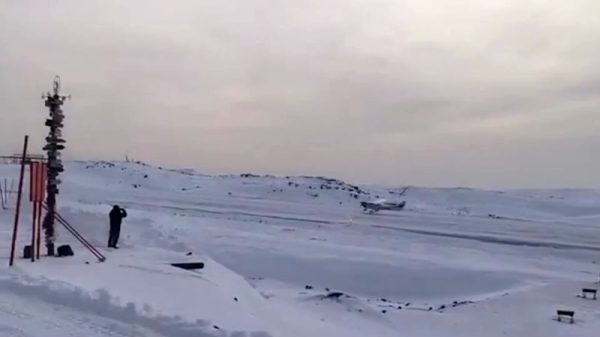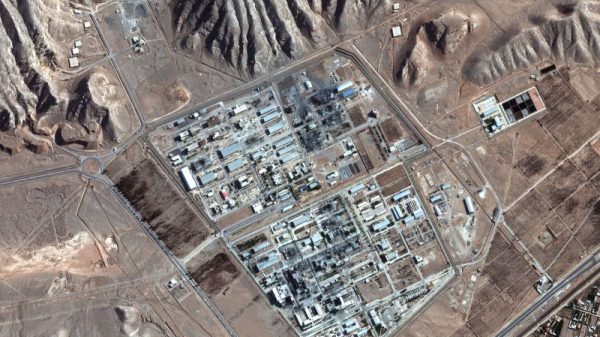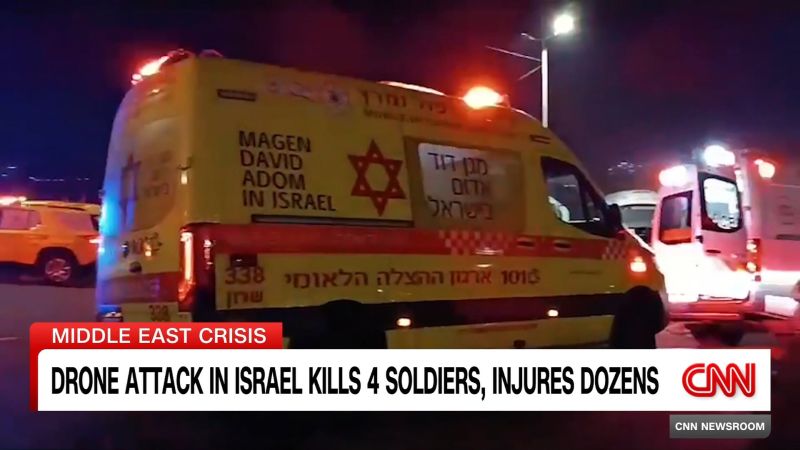The deadly attack by Hezbollah against an army base deep inside Israeli territory presents a major headache for Israel as it continues to struggle to defuse the threat from the Iran-backed militant group, despite launching a major bombardment campaign and a ground operation against it.
Launched from southern Lebanon, a drone was able to penetrate Israeli air defenses undetected and hit the Golani Brigade’s base some 40 miles into Israel from the border. It struck on Sunday just after 7pm – at dinner time – and while the military has not released any details about the impact site, photos from the scene make it clear the drone hit the base’s dining hall.
Both the timing and the location of the strike suggest that Hezbollah had gathered enough intelligence and possesses the capabilities to maximize the number of casualties. The Golani Brigade is regarded as an elite Israeli infantry unit and has been deployed to southern Lebanon as part of Israel’s ground operation there.
Four soldiers were killed, and more than 60 others were injured, eight of them seriously, bringing the total number of Israel Defense Forces (IDF) soldiers killed since the start of the ground operation two weeks ago to at least 18.
Sunday’s assault is also the single bloodiest attack on IDF troops inside Israel since the beginning of the war last October.
Daniel Sobelman, an international security expert at the Hebrew University of Jerusalem, said that it shows Hezbollah is still able to strike.
Israel’s air defense systems are impressive, intercepting and destroying most projectiles fired towards the country. But they have been designed and developed primarily to counter rockets and missiles, not drones that can be launched from anywhere, fly low and slow, and change directions quickly.
Iran and its allies are seeking to overwhelm Israel’s defense systems, Mizrahi said, adding drones to the equation after identifying them as “a weakness” for Israel.
“Every time we find a solution for something, they find another way to attack,” she said.
Residents in Israel are well trained when it comes to evading dangers from above. Most people head to the shelters – omnipresent in much of the country – or duck down in a ditch whenever they hear the sirens indicating an imminent aerial threat.
But the drone sent by Hezbollah at the weekend managed to slip through without triggering Israel’s alert systems. The soldiers in the dining hall were attacked without any warning.
And it was not the first time this has happened.
In June, Hezbollah released a nine-minute video filmed by a drone showing civilian and military locations in and around one of Israel’s largest cities, Haifa. That UAV also appeared to have gone undetected by the IDF.
In response to the video, IDF chief of staff Herzi Halevi said at the time that the Israeli military was “preparing and coming up with solutions to deal with these and other capabilities.”
Then in July, a drone launched by Iran-backed Houthi rebels from Yemen killed one man and injured at least 10 others in Tel Aviv. No sirens were activated during that attack. The IDF said two drones were fired and that while one was intercepted, the other one was not – due to what it said was a human error.
The tactic of sending two drones also appears to have been replicated by Hezbollah last week.
The IDF said two drones were launched from Lebanon on Friday, adding that it had intercepted one of them, but not disclosing what happened to the other one. A nursing home in the coastal city of Herzliya, central Israel, was damaged in the attack, but no casualties were reported.
It is very likely that the same strategy was deployed on Sunday. Shortly before the first reports of the attack against the Golani Brigade base, the IDF said it had intercepted an UAV launched from Lebanon in the northern naval area of Israel. That suggests the drone that hit the base was a second aircraft fired either simultaneously or shortly before or after the first one. The IDF did not comment on the number of drones that were launched on Sunday.
Hezbollah said it had fired dozens of rockets toward the northern Israeli towns of Nahariya and Acre to engage Israel’s air defense systems, while simultaneously launching the drones.
Difficult fight
Hezbollah continues to be able to fire at Israel despite the IDF launching an intense aerial bombardment inside Lebanon as well as a limited ground operation targeting the group.
When the IDF launched its ground operation against Hezbollah in southern Lebanon, it insisted that any action across the border would be “limited” in both geographical scope and duration and aimed at dismantling Hezbollah’s military infrastructure in the border areas.
Some 60,000 people have been evacuated from northern Israel since Hezbollah began firing barrages of rockets at Israel on October 8 last year in support of Hamas in Gaza, which had launched deadly attacks against Israel a day earlier.
But the reality on the ground indicates Israel might be preparing for the possibility of a much bigger war. It has deployed units from four divisions to southern Lebanon and ordered the residents of a quarter of Lebanon’s territory to evacuate. More than 1.2 million people are now displaced, according to the United Nations.
The IDF doesn’t disclose its troop numbers, but each division is thought to consist of some 10,000 to 20,000 soldiers.
Analysts at the Center for Strategic and International Studies (CSIS) said that last time Israel invaded Lebanon in 2006, it sent around 30,000 troops across the border.
That war ended in stalemate after 34 days, after some 1,100 Lebanese and about 170 Israelis, including 120 soldiers, were killed.
CSIS said that a new operation on the ground could require a bigger force than the one Israel deployed in 2006 against Hezbollah. Yet even that may not be enough.
He said that in guerrilla wars, what often matters the most is the weaker actor’s ability to keep going, fight and inflict losses on the other side.
With the IDF death toll from its war on Hezbollah rising, it is clear the militant group is determined to keep going – despite the momentous blows it has suffered.







































